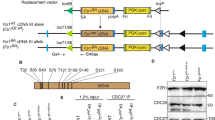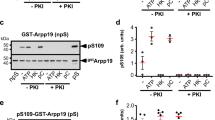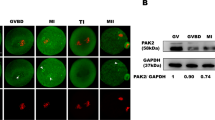Abstract
Until fertilization, the meiotic cell cycle of vertebrate eggs is arrested at metaphase of meiosis II by a cytoplasmic activity termed cytostatic factor (CSF)1, which causes inhibition of the anaphase-promoting complex/cyclosome (APC/C), a ubiquitin ligase that targets mitotic cyclins—regulatory proteins of meiosis and mitosis—for degradation2,3. Recent studies indicate that Erp1/Emi2, an inhibitor protein for the APC/C, has an essential role in establishing and maintaining CSF arrest4,5,6, but its relationship to Mos, a mitogen-activated protein kinase (MAPK) kinase kinase that also has an essential role in establishing CSF arrest7 through activation of p90 ribosomal S6 kinase (p90rsk)8,9, is unclear. Here we report that in Xenopus eggs Erp1 is a substrate of p90rsk, and that Mos-dependent phosphorylation of Erp1 by p90rsk at Thr 336, Ser 342 and Ser 344 is crucial for both stabilizing Erp1 and establishing CSF arrest in meiosis II oocytes. Semi-quantitative analysis with CSF-arrested egg extracts reveals that the Mos-dependent phosphorylation of Erp1 enhances, but does not generate, the activity of Erp1 that maintains metaphase arrest. Our results also suggest that Erp1 inhibits cyclin B degradation by binding the APC/C at its carboxy-terminal destruction box10, and this binding is also enhanced by the Mos-dependent phosphorylation. Thus, Mos and Erp1 collaboratively establish and maintain metaphase II arrest in Xenopus eggs. The link between Mos and Erp1 provides a molecular explanation for the integral mechanism of CSF arrest in unfertilized vertebrate eggs.
This is a preview of subscription content, access via your institution
Access options
Subscribe to this journal
Receive 51 print issues and online access
$199.00 per year
only $3.90 per issue
Buy this article
- Purchase on Springer Link
- Instant access to full article PDF
Prices may be subject to local taxes which are calculated during checkout




Similar content being viewed by others
Change history
26 April 2007
The addition of the word 'kinase' in the 9th line of the abstract
References
Masui, Y. & Markert, C. L. Cytoplasmic control of nuclear behavior during meiotic maturation of frog oocytes. J. Exp. Zool. 177, 129–145 (1971)
Harper, J. W., Burton, J. L. & Solomon, M. J. The anaphase-promoting complex: it's not just for mitosis any more. Genes Dev. 16, 2179–2206 (2002)
Peters, J. M. The anaphase-promoting complex: proteolysis in mitosis and beyond. Mol. Cell 9, 931–943 (2002)
Schmidt, A. et al. Xenopus polo-like kinase Plx1 regulates XErp1, a novel inhibitor of APC/C activity. Genes Dev. 19, 502–513 (2005)
Tung, J. J. et al. A role for the anaphase-promoting complex inhibitor Emi2/XErp1, a homolog of early mitotic inhibitor 1, in cytostatic factor arrest of Xenopus eggs. Proc. Natl Acad. Sci. USA 102, 4318–4323 (2005)
Shoji, S. et al. Mammalian Emi2 mediates cytostatic arrest and transduces the signal for meiotic exit via Cdc20. EMBO J. 25, 834–845 (2006)
Sagata, N., Watanabe, N., Vande Woude, G. F. & Ikawa, Y. The c-mos proto-oncogene product is a cytostatic factor responsible for meiotic arrest in vertebrate eggs. Nature 342, 512–518 (1989)
Bhatt, R. R. & Ferrell, J. E. The protein kinase p90 rsk as an essential mediator of cytostatic factor activity. Science 286, 1362–1365 (1999)
Gross, S. D., Schwab, M. S., Lewellyn, A. L. & Maller, J. L. Induction of metaphase arrest in cleaving Xenopus embryos by the protein kinase p90Rsk. Science 286, 1365–1367 (1999)
Miller, J. J. et al. Emi1 stably binds and inhibits the anaphase-promoting complex/cyclosome as a pseudosubstrate inhibitor. Genes Dev. 20, 2410–2420 (2006)
Masui, Y. The elusive cytostatic factor in the animal egg. Nature Rev. Mol. Cell Biol. 1, 228–232 (2000)
Kishimoto, T. Cell-cycle control during meiotic maturation. Curr. Opin. Cell Biol. 15, 654–663 (2003)
Tunquist, B. J. & Maller, J. L. Under arrest: cytostatic factor (CSF)-mediated metaphase arrest in vertebrate eggs. Genes Dev. 17, 683–710 (2003)
Liu, J. & Maller, J. L. Calcium elevation at fertilization coordinates phosphorylation of XErp1/Emi2 by Plx1 and CaMK II to release metaphase arrest by cytostatic factor. Curr. Biol. 15, 1458–1468 (2005)
Rauh, N. R., Schmidt, A., Bormann, J., Nigg, E. A. & Mayer, T. U. Calcium triggers exit from meiosis II by targeting the APC/C inhibitor XErp1 for degradation. Nature 437, 1048–1052 (2005)
Hansen, D. V., Tung, J. J. & Jackson, P. K. CaMKII and polo-like kinase 1 sequentially phosphorylate the cytostatic factor Emi2/XErp1 to trigger its destruction and meiotic exit. Proc. Natl Acad. Sci. USA 103, 608–613 (2006)
Lorca, T. et al. Calmodulin-dependent protein kinase II mediates inactivation of MPF and CSF upon fertilization of Xenopus eggs. Nature 366, 270–273 (1993)
Schmidt, A., Rauh, N. R., Nigg, E. A. & Mayer, T. U. Cytostatic factor: an activity that puts the cell cycle on hold. J. Cell Sci. 119, 1213–1218 (2006)
Haccard, O. et al. Induction of metaphase arrest in cleaving Xenopus embryos by MAP kinase. Science 262, 1262–1265 (1993)
Yamamoto, T. M., Iwabuchi, M., Ohsumi, K. & Kishimoto, T. APC/C–Cdc20-mediated degradation of cyclin B participates in CSF arrest in unfertilized Xenopus eggs. Dev. Biol. 279, 345–355 (2005)
Murray, A. W. & Kirschner, M. W. Cyclin synthesis drives the early embryonic cell cycle. Nature 339, 275–280 (1989)
Lohka, M. J. & Maller, J. L. Induction of nuclear envelope breakdown, chromosome condensation, and spindle formation in cell-free extracts. J. Cell Biol. 101, 518–523 (1985)
Murray, A. W., Solomon, M. J. & Kirschner, M. W. The role of cyclin synthesis and degradation in the control of maturation promoting factor activity. Nature 339, 280–286 (1989)
Ohsumi, K., Koyanagi, A., Yamamoto, T. M., Gotoh, T. & Kishimoto, T. Emi1-mediated M-phase arrest in Xenopus eggs is distinct from cytostatic factor arrest. Proc. Natl Acad. Sci. USA 101, 12531–12536 (2004)
Gotoh, Y. et al. Characterization of recombinant Xenopus MAP kinase kinases mutated at potential phosphorylation sites. Oncogene 9, 1891–1898 (1994)
Dupre, A., Jessus, C., Ozon, R. & Haccard, O. Mos is not required for the initiation of meiotic maturation in Xenopus oocytes. EMBO J. 21, 4026–4036 (2002)
Dumont, J., Umbhauer, M., Rassinier, P., Hanauer, A. & Verlhac, M. H. p90Rsk is not involved in cytostatic factor arrest in mouse oocytes. J. Cell Biol. 169, 227–231 (2005)
Lefebvre, C. et al. Meiotic spindle stability depends on MAPK-interacting and spindle-stabilizing protein (MISS), a new MAPK substrate. J. Cell Biol. 157, 603–613 (2002)
Iwabuchi, M., Ohsumi, K., Yamamoto, T. M., Sawada, W. & Kishimoto, T. Residual Cdc2 activity remaining at meiosis I exit is essential for meiotic M–M transition in Xenopus oocyte extracts. EMBO J. 19, 4513–4523 (2000)
Acknowledgements
We thank J. L. Maller and M. Iwabuchi for antibodies, M. Mori for CA- and KD-p90rsk2 proteins, K. Tachibana and E.Okumura for discussions, and M. J. Lohka and L. A. Jaffe for reading the manuscript. This work was also supported by grants from the Ministry of Education, Culture, Sports, Science and Technology of Japan to K.O. and T.K.
Author information
Authors and Affiliations
Corresponding author
Ethics declarations
Competing interests
Reprints and permissions information is available at www.nature.com/reprints. The authors declare no competing financial interests.
Supplementary information
Supplementary information
This file contains Supplementary Figures S1 – S7 with Legends, Supplementary Methods and additional references. (PDF 1668 kb)
Rights and permissions
About this article
Cite this article
Nishiyama, T., Ohsumi, K. & Kishimoto, T. Phosphorylation of Erp1 by p90rsk is required for cytostatic factor arrest in Xenopus laevis eggs. Nature 446, 1096–1099 (2007). https://doi.org/10.1038/nature05696
Received:
Accepted:
Published:
Issue Date:
DOI: https://doi.org/10.1038/nature05696
This article is cited by
-
Post-translational regulation of the maternal-to-zygotic transition
Cellular and Molecular Life Sciences (2018)
-
The p90 ribosomal S6 kinase 2 specifically affects mitotic progression by regulating the basal level, distribution and stability of mitotic spindles
Experimental & Molecular Medicine (2016)
-
Emi2 mediates meiotic MII arrest by competitively inhibiting the binding of Ube2S to the APC/C
Nature Communications (2014)
-
Modulation of cell cycle control during oocyte-to-embryo transitions
The EMBO Journal (2013)
-
Greatwall kinase and cyclin B-Cdk1 are both critical constituents of M-phase-promoting factor
Nature Communications (2012)
Comments
By submitting a comment you agree to abide by our Terms and Community Guidelines. If you find something abusive or that does not comply with our terms or guidelines please flag it as inappropriate.



